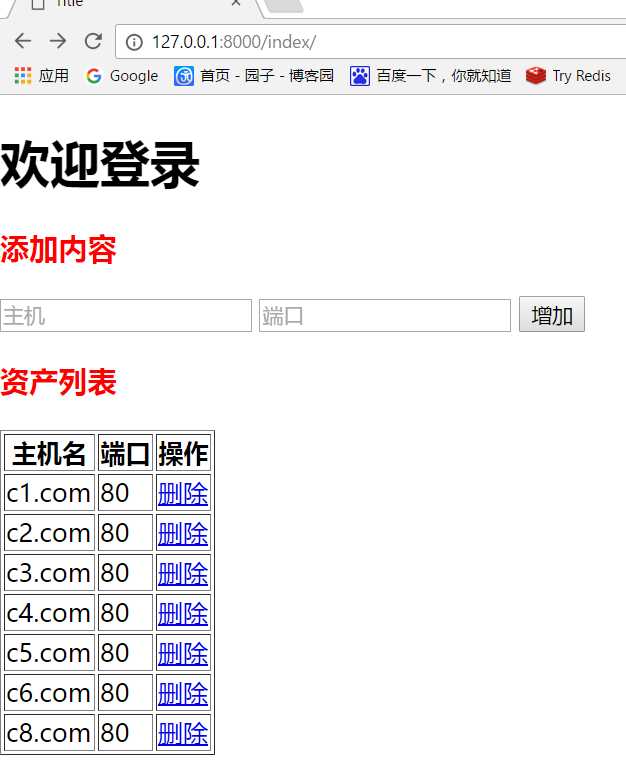标签:class pos tps dex 读取 direct border list inpu
实现功能:
登录功能
添加功能
删除功能(未实现)
代码:
index.html
<!DOCTYPE html> <html lang="en"> <head> <meta charset="UTF-8"> <title>Title</title> <link rel="stylesheet" href="/static/commons.css" /> </head> <body> <h1>欢迎登录</h1> {# <img src="/static/1.png">#} <h3>添加内容</h3> <form action="/index/" method="POST"> <input type="text" placeholder="主机" name="host" /> <input type="text" placeholder="端口" name="port" /> <input type="submit" value="增加" /> </form> <h3>资产列表</h3> <table border="1"> <thead> <tr> <th>主机名</th> <th>端口</th> <th>操作</th> </tr> </thead> <tbody> {% for row in data %} <tr> <td>{{ row.hostname }}</td> <td>{{ row.port }}</td> <td><a href="/delete/?h={{ row.hostname }}">删除</a></td> </tr> {% endfor %} </tbody> </table> </body> </html>
login.html
<!DOCTYPE html> <html lang="en"> <head> <meta charset="UTF-8"> <title>Title</title> </head> <body> <form action="/login/" method="POST"> <p>用户名<input type="text" name="user" /></p> <p>密码<input type="text" name="pwd" /></p> <input type="submit" value="提交" /> </form> </body> </html>
views.py
from django.shortcuts import render,HttpResponse,redirect # from django.shortcuts import HttpResponse # Create your views here. #至少一个参数request #request封装用户请求相关信息 DB=[ {‘hostname‘:‘c1.com‘,‘port‘:80}, {‘hostname‘:‘c2.com‘,‘port‘:80}, {‘hostname‘:‘c3.com‘,‘port‘:80}, {‘hostname‘:‘c4.com‘,‘port‘:80}, {‘hostname‘:‘c5.com‘,‘port‘:80}, {‘hostname‘:‘c6.com‘,‘port‘:80}, ] def index(request): # print(request.GET) #return HttpResponse(‘<h1 style="color:red;">OK</h1>‘) if request.method == "GET": #获取数据pymysql #模块渲染 """ 1、读取html文件内容 NB.将特殊的标记和{‘data‘:DB}进入渲染,得到一个字符串 2、将html内容返回给用户 """ return render(request,‘index.html‘,{‘data‘: DB}) if request.method == ‘POST‘: host = request.POST.get(‘host‘) port = request.POST.get(‘port‘) #拿到数据加到字典里面去 temp = {‘hostname‘: host,‘port‘:port} DB.append(temp) # return render(request, ‘index.html‘,{‘data‘: DB}) return redirect(‘/index/‘) def login(request): #request.method "GET" "POST" if request.method == ‘GET‘: #request.GET.get() return render(request,‘login.html‘) elif request.method == ‘POST‘: # 获取用户提交的数据(POST) username = request.POST.get(‘user‘) password = request.POST.get(‘pwd‘) if username == ‘root‘ and password == ‘123‘: # return redirect(‘http://www.baidu.com‘) return redirect(‘/index/‘) else: return render(request,‘login.html‘)
settings.py
""" Django settings for cmdb project. Generated by ‘django-admin startproject‘ using Django 1.10.5. For more information on this file, see https://docs.djangoproject.com/en/1.10/topics/settings/ For the full list of settings and their values, see https://docs.djangoproject.com/en/1.10/ref/settings/ """ import os # Build paths inside the project like this: os.path.join(BASE_DIR, ...) BASE_DIR = os.path.dirname(os.path.dirname(os.path.abspath(__file__))) # Quick-start development settings - unsuitable for production # See https://docs.djangoproject.com/en/1.10/howto/deployment/checklist/ # SECURITY WARNING: keep the secret key used in production secret! SECRET_KEY = ‘v5f(=a7$&q^tx55iu1p53jf(gi=oq9y&t07b+w6#f+6tx_ngif‘ # SECURITY WARNING: don‘t run with debug turned on in production! DEBUG = True ALLOWED_HOSTS = [] # Application definition INSTALLED_APPS = [ ‘django.contrib.admin‘, ‘django.contrib.auth‘, ‘django.contrib.contenttypes‘, ‘django.contrib.sessions‘, ‘django.contrib.messages‘, ‘django.contrib.staticfiles‘, ‘monitor‘, ] MIDDLEWARE = [ ‘django.middleware.security.SecurityMiddleware‘, ‘django.contrib.sessions.middleware.SessionMiddleware‘, ‘django.middleware.common.CommonMiddleware‘, # ‘django.middleware.csrf.CsrfViewMiddleware‘, ‘django.contrib.auth.middleware.AuthenticationMiddleware‘, ‘django.contrib.messages.middleware.MessageMiddleware‘, ‘django.middleware.clickjacking.XFrameOptionsMiddleware‘, ] ROOT_URLCONF = ‘cmdb.urls‘ TEMPLATES = [ { ‘BACKEND‘: ‘django.template.backends.django.DjangoTemplates‘, ‘DIRS‘: [os.path.join(BASE_DIR, ‘templates‘)] , ‘APP_DIRS‘: True, ‘OPTIONS‘: { ‘context_processors‘: [ ‘django.template.context_processors.debug‘, ‘django.template.context_processors.request‘, ‘django.contrib.auth.context_processors.auth‘, ‘django.contrib.messages.context_processors.messages‘, ], }, }, ] WSGI_APPLICATION = ‘cmdb.wsgi.application‘ # Database # https://docs.djangoproject.com/en/1.10/ref/settings/#databases DATABASES = { ‘default‘: { ‘ENGINE‘: ‘django.db.backends.sqlite3‘, ‘NAME‘: os.path.join(BASE_DIR, ‘db.sqlite3‘), } } # Password validation # https://docs.djangoproject.com/en/1.10/ref/settings/#auth-password-validators AUTH_PASSWORD_VALIDATORS = [ { ‘NAME‘: ‘django.contrib.auth.password_validation.UserAttributeSimilarityValidator‘, }, { ‘NAME‘: ‘django.contrib.auth.password_validation.MinimumLengthValidator‘, }, { ‘NAME‘: ‘django.contrib.auth.password_validation.CommonPasswordValidator‘, }, { ‘NAME‘: ‘django.contrib.auth.password_validation.NumericPasswordValidator‘, }, ] # Internationalization # https://docs.djangoproject.com/en/1.10/topics/i18n/ LANGUAGE_CODE = ‘en-us‘ TIME_ZONE = ‘UTC‘ USE_I18N = True USE_L10N = True USE_TZ = True # Static files (CSS, JavaScript, Images) # https://docs.djangoproject.com/en/1.10/howto/static-files/ STATIC_URL = ‘/static/‘ STATICFILES_DIRS = ( os.path.join(BASE_DIR,‘static‘), )
urls.py
"""cmdb URL Configuration The `urlpatterns` list routes URLs to views. For more information please see: https://docs.djangoproject.com/en/1.10/topics/http/urls/ Examples: Function views 1. Add an import: from my_app import views 2. Add a URL to urlpatterns: url(r‘^$‘, views.home, name=‘home‘) Class-based views 1. Add an import: from other_app.views import Home 2. Add a URL to urlpatterns: url(r‘^$‘, Home.as_view(), name=‘home‘) Including another URLconf 1. Import the include() function: from django.conf.urls import url, include 2. Add a URL to urlpatterns: url(r‘^blog/‘, include(‘blog.urls‘)) """ from django.conf.urls import url from django.contrib import admin from monitor import views urlpatterns = [ url(r‘^admin/‘, admin.site.urls), url(r‘^index/‘, views.index), url(r‘^login/‘, views.login), ]
运行效果:

标签:class pos tps dex 读取 direct border list inpu
原文地址:http://www.cnblogs.com/nulige/p/6510166.html